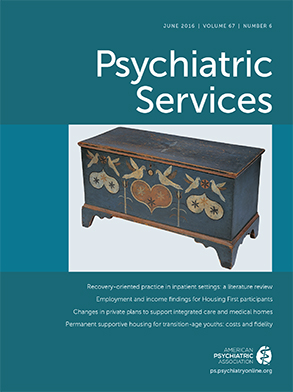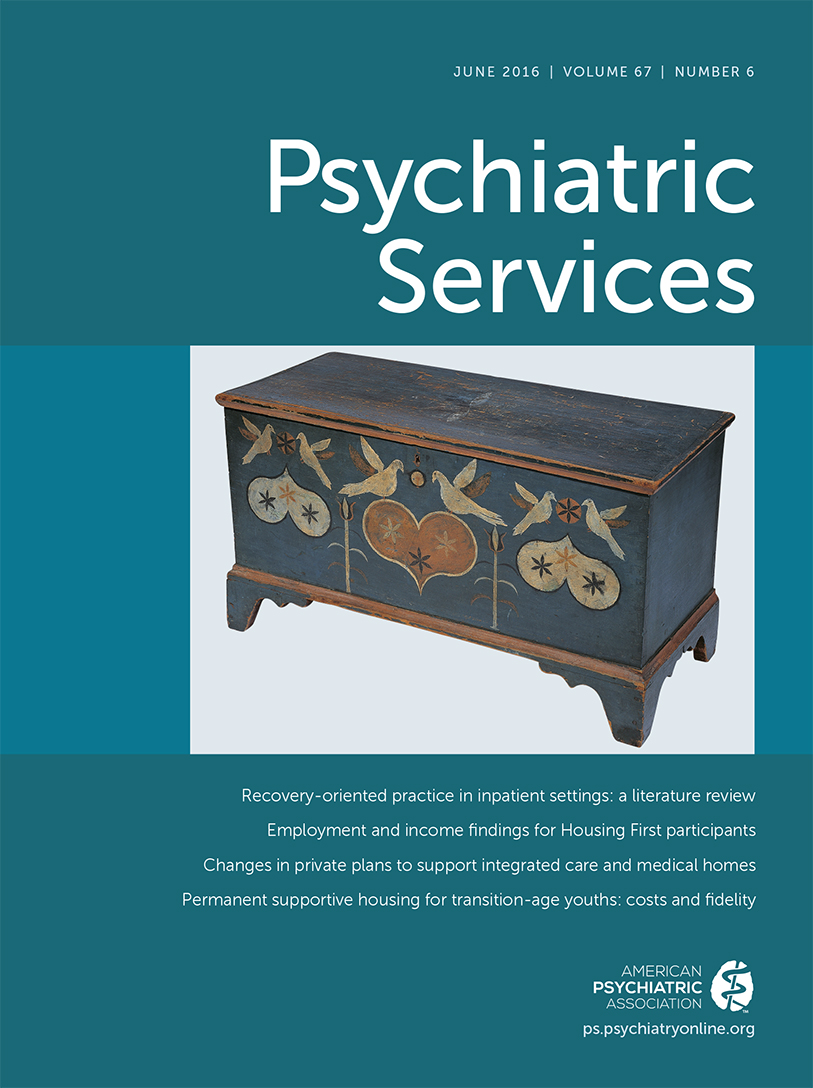A subpopulation for which treatment engagement research is needed is firefighters. Recent research has revealed that rates of suicide ideation, plans, and attempts among firefighters during their careers (
4) exceed rates found in the general population (
5). This may be the result of certain job-related stressors (for example, trauma exposure) that confer an increased risk of suicide (
6). Firefighters also appear to be at increased risk of psychiatric disorders associated with elevated suicide risk (
7,
8). To date, however, no studies have examined patterns of service use in this population.
Using data from a national Web-based survey of current and retired firefighters, this study aimed to identify the prevalence of mental health service use, types of care accessed, correlates of service use, and barriers to help seeking among firefighters reporting a history of suicide ideation, plans, or attempts during their firefighting careers.
Methods
Participants included current and retired firefighters (N=483) reporting a history of suicide ideation, plans, or attempts during their firefighting careers. Retired firefighters were asked to report experiences during their years of service, and they were included in this study because data from retired firefighters were expected to inform assessment of service use among individuals with longer firefighting careers.
An adapted, self-report version of the Self-Injurious Thoughts and Behaviors Interview–Short Form (SITBI-SF) (
9) was used to assess participants’ experiences with suicidal thoughts and behaviors during their firefighting careers. The SITBI-SF has been used in self-report format (
10) and has demonstrated good test-retest reliability as a self-report measure (
10) and strong psychometric properties as an interview measure (
9). Questions adapted from the National Survey on Drug Use and Health (
11) probed participants’ history of psychiatric hospitalizations, psychiatric medication use, and types of mental health services used. The Perceived Stigma Scale (
12) assessed structural and stigma-related barriers that might affect participants’ decisions to seek treatment for a psychological problem.
This study was part of a larger investigation on firefighter behavioral health (N=1,027) that recruited participants through e-mail Listservs and social media outlets managed by various firefighter organizations (
4). A formal sampling strategy was not implemented, and response rates were not determinable. Participants reviewed a Web-based consent form and then completed a 30-minute self-report survey administered through Qualtrics, a Web-based platform. Participants were then provided with a list of national mental health resources (for example, the National Suicide Prevention Lifeline [1-800-273-TALK]) and the option to receive a $10 gift card for survey participation. The Florida State University Institutional Review Board approved all procedures.
Only participants reporting a history of suicide ideation, plans, or attempts during their firefighting careers (N=483) were included in the analyses reported here. No demographic differences were found between this subsample and the full sample. Participants were categorized as having a suicide attempt (attempt history, N=156), a suicide plan (plan but no attempts, N=53), or suicide ideation (ideation only, N=274). Categories were mutually exclusive. Descriptive statistics, chi square tests, and logistic regression modeling that controlled for suicidal behavior type were used to analyze service use patterns. Unadjusted odds ratios are reported.
Results
Demographic characteristics were as follows: 91% male (N=433), mean±SD age, 36.39±10.92 (range, 18–65), and 81% (N=390) white or Caucasian, 15% (N=75) Native American/Alaska Native, and 4% (N=18) other. Firefighter characteristics were as follows: 92% (N=445) current and 8% (N=38) retired; mean of 11.53±8.53 years of service (range, 1–30); 38% (N=185) full-time, 31% (N=152) volunteer, 29% (N=138) hybrid, and 2% (N=8) military or wildland; and 48% (N=222) lower rank, 33% (N=152) higher rank, 14% (N=64) officer, and 5% (N=21) other. Finally, 36% (N=174) reported a military service history, which was assessed because service members and veterans have elevated suicide risk yet low service use rates (
13).
Overall, 77% of participants reported receiving some form of mental health treatment during their time in the fire service and were most likely to have received services from a psychologist, therapist, or counselor (63%) (
Table 1). Those reporting an attempt were the most likely to have received services (93%), and lower service use rates were found among those with plans but no attempts (77%; χ
2=9.82, df=1, p=.002) and ideation only (68%; χ
2=36.02, df=1, p<.001). Those with a past attempt were also more likely to have taken psychiatric medications (80%) and to have received outpatient counseling or treatment (92%) than those with a plan (53%, χ
2=8.70, df=1, p=.003; 77%, χ
2=4.17, df=1, p<.001, respectively) or ideation only (34%, χ
2=81.18, df=1, p<.001; 66%, χ
2=37.91, df=1, p<.001, respectively).
Participants were more likely to report stigma-related barriers to care (58%, N=281) than structural barriers (43%, N=209) (χ2=95.21, df=1, p<.001). Only two variables were significantly associated with service nonuse: concerns about embarrassment (B=–.729, SE=.105, p=.008) and harm to one’s reputation (B=–.204, SE=.096, p=.034). The most commonly reported structural barrier was cost (35%, N=169), followed by getting time off (20%, N=95), not knowing where to go (17%, N=82), scheduling difficulties (16%, N=79), and transportation difficulties (9%, N=41). The most frequently cited stigma-related barrier was concerns about being treated differently by peers (44%, N=210), followed by concerns of appearing weak (42%, N=205), having a harmed reputation (41%, N=198), being thought less of by others (37%, N=178), embarrassment (30%, N=147), and being blamed (26%, N=126).
For correlates of service use, individuals ages 35–44 years and 45–54 were more likely to have received services than those ages 18–24 years (odds ratio [OR]=1.81, 95% confidence interval [CI]=1.11–2.94; and OR=1.81, CI=1.01–3.00, respectively). Also, individuals in higher income brackets were more likely than those with an annual household income below $20,000 to have received care ($40,000–$59,000, OR=4.31, CI=1.56–11.90; $60,000–$79,000, OR=3.61, CI=1.33–9.81; $80,000–$99,000, OR=5.33, CI=1.94–14.69; and >$100,000, OR=4.46, CI=1.68–11.88). Participants with 21–30 years of service were twice as likely to have used mental health services as those with 0–10 years of service (OR=2.10, CI=1.45–3.05). Volunteer (OR=.60, CI=.43–.85) and military or wildland (OR=.27, CI=.10–.78) firefighters were less likely than full-time firefighters to have used services. Finally, compared with firefighters serving in large cities, those in small towns (OR=.58, CI=.36–.93) and rural areas (OR=.47, CI=.26–.86) were less likely to have used services. No significant differences in service use emerged by sex, race-ethnicity, religion, education, and military status or between current and retired firefighters.
Discussion
Firefighters in this study with a history of suicide ideation, plans, or attempts reported a noticeably higher rate of service use (77%) than adults in the general population with a similar history (<50%) (
2,
14). Service use rates increased with increasing severity of suicidal behavior type, suggesting that many firefighters at highest risk (that is, those with a past attempt) are seeking treatment. Furthermore, the finding that at-risk firefighters sought services from a range of individuals emphasizes the critical need to ensure that providers across specialties (for example, physicians, nurses, and clergy) and settings (for example, primary care setting and emergency departments) are equipped to work with suicidal individuals (
15).
Notably, the only barriers to care that differentiated service users from nonusers were concerns about reputation and embarrassment, underscoring the need to develop stigma-focused interventions. It is also worthwhile to note that aside from these two barriers, service users and nonusers endorsed each barrier at comparable rates, suggesting that even individuals who previously utilized services still have reservations and concerns about seeking treatment. This finding not only emphasizes the potentially daunting nature of connecting with care but also suggests that even when barriers to care are present, individuals still seek treatment, which highlights the dynamic interplay between barriers to and facilitators of service use.
In terms of correlates of service use, the finding that firefighters serving in rural areas or small towns, as well as those with lower incomes, were less likely to have used mental health services emphasizes a need for expansion of accessible and affordable care options. In addition, specific efforts to facilitate service use among volunteer firefighters may be indicated because they were less likely than their full-time peers to have received services and may have external career responsibilities that limit their ability to seek treatment. Finally, firefighters with more years of service were more likely to have sought care than those with fewer years of service, perhaps because individuals may become more receptive to a need for treatment over time, particularly if problems are unremitting. Alternatively, firefighters may be more likely to leave the fire service as a result of untreated mental health problems, resulting in higher service use rates among those who have maintained their firefighter status.
This study’s limitations should also be considered. Because a convenience sample was used and because analyses included retired firefighters, results may not generalize to the experiences of current firefighters nationally or globally. Replication of this study using a probability sampling strategy is warranted. It is also recommended that future studies employ a measure of suicidal ideation and behaviors validated for self-report use, establish the temporal relationship between service use and suicidal behaviors, and assess whether firefighters used services to address suicidality, specifically.

